Posts Tagged ‘Error Coin’
Sir Isaac Newton 50p becomes EVEN MORE collectible
The Sir Isaac Newton 50p is one of the most popular 50ps in circulation. Shortly after it was issued in 2017, it ranked as the second rarest 50p in circulation after the Kew Gardens 50p, with a mintage figure of just 1.8 million.
Due to its huge popularity, the following year The Royal Mint announced that collectors would be able to strike their own 2018 dated Sir Isaac Newton 50p at The Royal Mint Experience. The 2018 dated coin became one of the rarest 50ps, as the only way to get one was to strike your own.
What makes this 50p so popular?
The coin’s incredibly detailed reverse design by Aaron West is based on elements of Propsition 11, in Book One of Newton’s Principia Mathematica. It also pays tribute to the legacy of Sir Isaac Newton, a genius of the Scientific Revolution and one of the most famous figures to ever hold the role of Master of the Mint.
Change Checkers even voted the 2017 Sir Isaac Newton 50p as their all time favourite Queen Elizabeth II circulating 50p in a poll last year.

An interesting error
As if this coin’s incredible popularity, intricate design and low mintage figure weren’t enough to make it extremely collectible, there’s something else you should look out for...
Several collectors have reported finding an error on their 2017 Sir Isaac Newton 50p. The reverse design looks normal, however the obverse appears to have several extra lines across Queen Elizabeth II’s portrait.
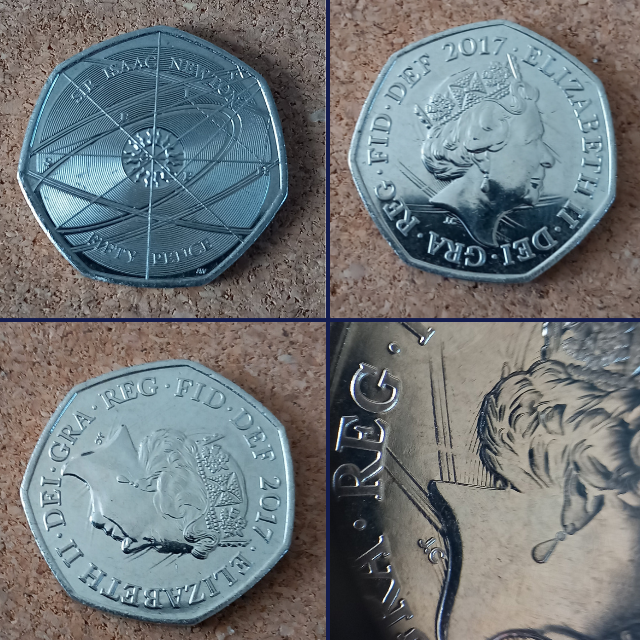
Credit: @The50pC on Twitter
This is thought to be an error caused during the striking process, a result of what is known as a die clash. Interestingly, the extra lines aren’t grooves scratched into the surface of the coin, but rather ‘whiskers’ standing slightly proud of the surface.
How rare is it?
Although we don’t know for sure how many of these error coins are in circulation, they’re thought to be extremely rare. They’ve even been listed on the secondary market for more than 100 times face value!
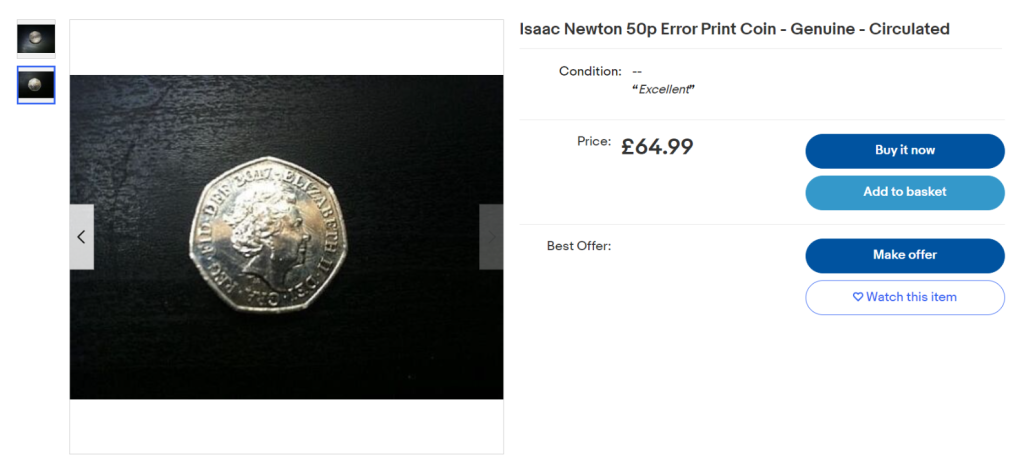
Always make sure you’re careful buying coins on the secondary market to avoid being overcharged.
Have you ever found an error coin in your change? Or perhaps you have this one? Let us know in the comments below!
Guarantee all new UK coins for you collection

Join the Change Checker UK CERTIFIED BU Subscription Service and receive the very latest UK coins sent to you door without the hassle of placing orders on the day of release!
Is your £1 coin worth £200?
Finding an error coin is like winning the lottery for collectors. And after reading today’s blog, you’ll be adding another rare error to your Change Checker watch list!
As earlier this month, a pub worker discovered a £1 coin that was minted from just ONE metal – not two – which went on to sell for £205 on the secondary market!
You see, normal £1 coins have a gold coloured Nickel-Brass outer ring and a silver coloured Nickel plated interior, but this rarity was completely gold-coloured. Check it out in the image below…
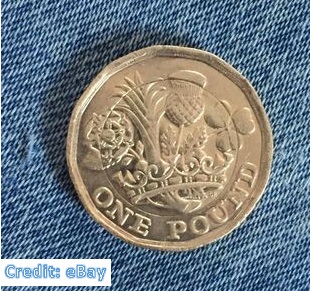
Understandably this lucky find was immediately added to eBay and the uniqueness of the coin meant there were 24 bids from five interested bidders, before it eventually sold on August 8 for the unbelievable price of £205!
Mad, right?
One explanation for the supposed ‘error’ could be that the coin missed the plating stage during production.
Whilst this is the first time we’ve heard of the ‘error’ being found on a £1 coin, similar stories have been reported on £2 coins before…
The Holy Grail of Bi-metallic Errors

The image above shows what has been described as the Holy Grail of bimetallic ‘errors’ and is the result of the nickel-brass £2 blank not having the inner core section punched out before being struck.
This means that the £2 coin is made from one full piece of nickel-brass, just like the £1 error above – completely contrasting the very idea of a bimetallic coin.
A 2007 monometallic £2 was verified by The Royal Mint and in the email confirming the mis-strike it was mentioned that they had only seen 4-5 similar coins before.
This rare striking error is highly sought after and coins have achieved extraordinary prices in private sales and auctions.
So if you don’t consider yourself a Change Checker, it might be time to rethink as these exceptional error coins could be lying unused at the bottom of your bag.
Have you ever discover an error coin? If so comment below as we’d love to hear all about your coin hunting experiences!
If you’re interested in coin collecting, our Change Checker web app is completely free to use and allows users to:
– Find and identify the coins in their pocket
– Collect and track the coins they have
– Swap their spare coins with other Change Checkers

Sign up today at: www.changechecker.org/app
Is your H.G. Wells £2 coin worth thousands? How to spot if you’ve got an ‘error’ coin!
Every keen collector knows that it is worthwhile paying close attention to the small details of your coins – it’s the only way you can ever hope to spot an error.
From edge inscription mix ups to inverted effigies, there are a few stories that crop up more often than not. However, recently, a couple of ‘error’ stories have cropped up, that Change Checker really think you should pay attention to – involving an H.G. Wells £2 and the Technology £2…
Stay tuned as we take a closer look at these ‘errors’ and help you determine if your £2 coin is a genuine rarity!
H.G. Wells £2 – Blank ‘Error’

This £2 coin was issued as part of the 2021 UK Commemorative Coin set and it marks the 75th anniversary of the death of science fiction novelist, H. G. Wells.
With the clue in the name, this bi-metallic coin is made up of a combination of a silver coloured cupro-nickel disc and an outer yellow nickel-brass ring.
In the case of this H.G. Wells £2 coin however, it appears that the blank used has a thicker yellow ring, much wider than what we’d see on normal £2 coins.
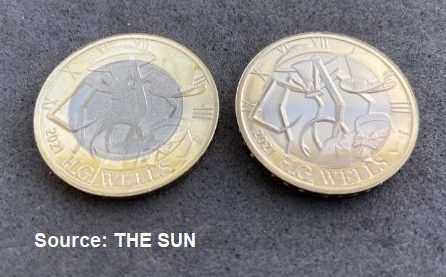
When striking £2 coins, the first step is to punch a hole through a blank planchet to create the outer section. The inner core is taken from a different metal, sized to fit inside the outer ring.
There have already been estimations that if this coin was to be sold at auction, it could fetch over £1,000! We’re going to be eagerly awaiting confirmation from The Royal Mint whether this error is genuine or not. Nonetheless, it certainly makes for interesting collecting!
This coin is yet to be individually issued, so any ‘error’ versions will have come exclusively from the 2021 UK Annual Set. It’ll certainly be interesting to see if any other stories crop up after the coin’s individual issue….
Whilst there are no identical examples to compare the H.G. Wells £2 ‘error’ to, there have been previous instances of the inner and outer sections of £2 coins not quite matching up:
Clipped Planchet

In the above image, the inner core was punched out from the end of the sheet of metal used for blanks, forming a straight or ragged edge clip.
Whilst this also occurs with monometallic coins, the pairing with an outer ring exposes a large gap which is much more noticeable.
The Royal Mint strike millions of coins each year so it is inevitable that variances will occur during the striking process and can’t always be picked up during quality control, despite the fact that this particular coin would weigh less than the standard 12g £2 coin.
Off Centre Inner Core

The inner core of this coin hasn’t been united properly prior to being struck, resulting in an off centre inner core.
Due to the way the inner and outer core are struck together with the two metals being lined up and then fused together during striking, a misalignment will mean that the inner core spills into the outer ring, as seen in the image above. There might also be a gap between the two metals on the opposing join.
Faulty Outer Ring

This particular mis-strike, shows a faulty planchet or outer ring, where the inner core is exposed.
In the image above, you can actually see the specific engineering design features where the inner core is grooved to help the metal flow bond to the outer ring and fuse during striking.
Similar to the first mis-strike we looked at, this could be caused by a clipped planchet, this time created when the outer ring was punched, however coins like this may also be caused by tampering post striking, for example by fakers trying to replace the inner core of a £2 with another coin to pass off as a rare error.
Bronze £2 Error
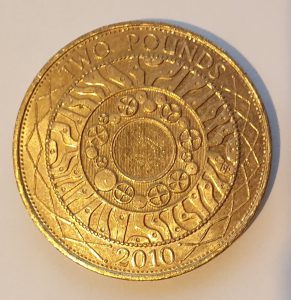
The ‘Monometallic’ £2 is described as the Holy Grail of bimetallic ‘errors’ and is the result of the nickel-brass £2 blank not having the inner core section punched out before being struck.
This means that the £2 coin is made from one full piece of nickel-brass, completely contrasting the very idea of a bimetallic coin.
A 2007 monometallic £2 was verified by The Royal Mint and in the email confirming the mis-strike it was mentioned that they had only seen 4-5 similar coins before.
However, in 2021, Change Checker was contacted by a collector called Amin who informed us that he had found this exact error coin but with a 2010 date.
After sending details of his coin to The Royal Mint for further information, it was confirmed to be genuine error as a result of the minting process.

This rare striking error is highly sought-after and coins have achieved extraordinary prices in private sales and auctions.
Whilst information of this coin’s sale has remained private, it’s certainly a very interesting story and we imagine the collector can expect to see a very impressive return on this coin…
We look forward to the individual release of the HG Wells £2 later this year and will certainly be keeping our eyes peeled for any unusual looking variations!
Have you ever come across any of these £2 error coins in your collection?
We’d love to know! Comment below.


